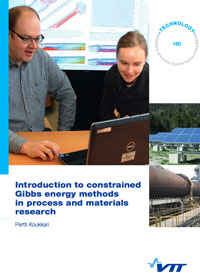| Posted: Jun 25, 2014 | |
Introduction to constrained Gibbs energy methods in process and materials research |
|
| (Nanowerk News) In process and materials chemistry, digitalization with computational methods has been a long-time continuing process. The methodology based on numerical methods in reaction kinetics as well as for fluid phase thermodynamics applying equations of state has been well established. | |
 During the last two decades, however, multiphase technology based on the minimization of Gibbs free energy has made progress in such fields of process and materials chemistry, where the conventional methods have not been applicable. Recent advancements also include introduction of such new Gibbs’ian algorithms, which, in addition to complex equilibrium problems, facilitate modelling of time-dependent dynamic changes in multi-phase systems. Within the said period, VTT has been an active performer in the development of multiphase Gibbs’ian techniques. The research work performed at VTT has led to several new algorithms with practical industrial applications. The particular focus has been the development of the Constrained Gibbs Free energy minimization technique, where instead of material balances and stoichiometric relations derived thereof, also immaterial physical conditions are applied as constraints in the free energy minimizing calculation. In this report ("Introduction to constrained Gibbs energy methods in process and materials research"; pdf), the method of constrained Gibbs energy minimization for calculating chemical equilibria in arbitrary multiphase systems is derived using basic thermodynamic concepts. The method of Lagrange undetermined multipliers is introduced for a simple system of an ideal gas phase and a number of condensed phases, constrained by the number of moles of the system components. The use of additional constraints in the Gibbs energy minimization procedure is facilitated by applying the concept of generalised work-coefficients as the Lagrange multipliers of immaterial components in the system. |
|
| The thus introduced method of immaterial constraints in Gibbs energy minimization is illustrated with a number of simple practical examples such as electrochemical Donnan equilibria applied for pulp suspensions, surface equilibria and systems constrained by reaction kinetics via the extent of chemical reactions. A few examples of non-equilibrium and parametric phase diagrams calculated with the immaterial constraints are also given. Finally, the applicability of the method for biochemical systems is shortly discussed. |
| Source: Technical Research Centre of Finland |
